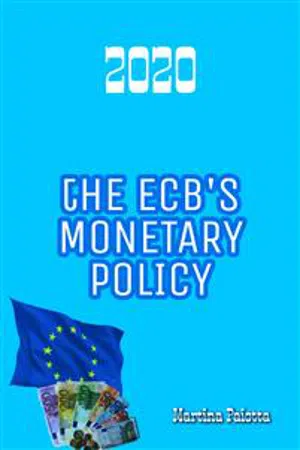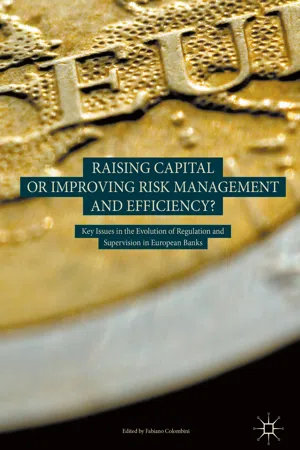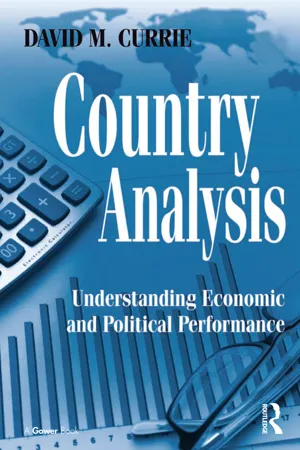ECB Monetary Policy
The European Central Bank (ECB) monetary policy refers to the strategies and actions implemented by the ECB to control the money supply, interest rates, and inflation within the Eurozone. This includes setting key interest rates, conducting open market operations, and providing liquidity to banks. The primary goal of the ECB's monetary policy is to maintain price stability and support economic growth within the Eurozone.
7 Key excerpts on "ECB Monetary Policy"
- eBook - ePub
- Martina Paiotta(Author)
- 2020(Publication Date)
- Youcanprint(Publisher)
...This is feasible in a system that sees GDP and inflation at very low levels and without a possible autonomous recovery. Restrictive monetary policy, concerns disproportionate GDP growth and inflation. It’s certainly a good thing, but it still needs to be checked to avoid a probable dissection after the peak. The monetary base is being narrowed and interest rates are increasing. Within the EU, setting interest rates and printing money is the responsibility of the ECB. So, as we can guess, monetary policy deals precisely with the situations about the currency. Let’s see how the ECB acts in terms of monetary policy: European monetary policy is managed through the European System of Central Banks, a body which is completely independent of other institutions. It is composed of a Governing Council and the Governors of the national central banks with a view to adopting the guidelines for monetary policy in the European area. The Eurozone area is referred to the Member States that have adopted the euro. From all this, we deduce that the ECB has a monopoly on the issue of money. The ECB must: maintain stable prices, support Eurozone policies, manage exchange rates and interest rates, manage foreign reserves, supervise Eurozone banks through appropriate systems, and ensure a sound and stable system. The ECB plays a very important role in both GDP and inflation. The ECB, through its policies, has the capacity to influence the amount of currency present in the Eurozone. In fact, this is done on the basis of market conditions and the policies it extends. Monetary Economy studies supply and demand in an economic system, and, of course, its consequences on the real economy. The main object of monetary economy is the exchange of money. The policies. of the ECB are directly reflected in both the financial and economic system of the Member States...
- eBook - ePub
Raising Capital or Improving Risk Management and Efficiency?
Key Issues in the Evolution of Regulation and Supervision in European Banks
- Fabiano Colombini, Fabiano Colombini(Authors)
- 2018(Publication Date)
- Palgrave Macmillan(Publisher)
...In the euro area, this transmission mechanism has been impeded in the past, initially by an increase in risk premia, due to doubts on the survival of the euro area and, later, by the widespread bank deleveraging. In this respect, it is necessary to discuss and evaluate the consequences of restrictive banking regulation and supervisory policy in relation to the capital adequacy framework. The supervisory policy would need to go beyond the capital and liquidity regulatory frameworks to support and not delay the effectiveness of the monetary policy measures. This chapter aims to analyse how the monetary policy, on the one hand, and the bank regulation and supervision, on the other, can mutually affect the economic growth in the euro area, focusing on the role of the banking channel. 8.2 Monetary Policy in Europe On January 1, 1999, the European Central Bank (ECB) assumed responsibility for the monetary policy decision-making in the euro area. The transfer of this responsibility from the national competent authorities (NCAs) to a new supranational institution represented a milestone in a long and complex process of integration among the European countries. Maintaining price stability, as the primary objective of monetary policy in the euro area, is a necessary condition to support the general policies of the European Union, aimed at achieving balanced economic growth. This purpose is pursued through the definition of intermediate objectives (interest rate, exchange rate, and amount of money) and appropriate instruments defined by the ECB, respecting the principles of market freedom, efficient allocation of resources, and an equal treatment of the counterparties (ECB, 2011). The purpose of price stability, which is to be exercised in the medium term, is to maintain the inflation rate at lower values, but close to two per cent...
- eBook - ePub
Country Analysis
Understanding Economic and Political Performance
- David M. Currie(Author)
- 2016(Publication Date)
- Routledge(Publisher)
...CHAPTER 6 Evaluating Monetary Policy Besides the government, the other major institution influencing economic conditions in a country is the central bank. Each nation’s government defines the objectives of the central bank, but generally a central bank is responsible for controlling the rate of inflation, which it accomplishes by influencing monetary conditions such as the level of interest rates. A central bank also may be responsible for influencing the level of employment, the value of the nation’s currency on the international currency market, and safety of the financial system, among other functions. In most cases, you can identify a nation’s central bank by filling in the blank in Bank of _______ with the name of a country: Bank of England, Nippon Ginko (Bank of Japan), Banque de France, or Banco Central do Brasil. In some countries, the central bank is called a reserve bank for reasons we discuss in this chapter: Reserve Bank of India, Reserve Bank of Australia, or Federal Reserve System in the US. When several of the countries of Europe decided to adopt a single currency, the euro, it was necessary for the countries to create a central bank, the European Central Bank. Learning Objectives After studying this chapter, you should be able to: 1. explain what money is and how it is created; 2. explain the purpose of a nation’s central bank; 3. explain how a central bank influences interest rates in an economy; 4. discuss the economic conditions that would cause a central bank to adjust interest rates upward or downward; 5. explain the consequences of a central bank adjusting interest rates upward or downward. What is Money? At first, the answer to this question seems obvious: money is what you buy things with. But in a developed country such as the US, people buy things with currency, checks, debit cards, credit cards, traveler’s checks, PayPal accounts, electronic transfers, and numerous other methods...
- eBook - ePub
- Michael Heine, Hansjorg Herr(Authors)
- 2020(Publication Date)
- Agenda Publishing(Publisher)
...Owners of monetary wealth may see themselves disadvantaged vis-à-vis owners of firms. Periods of low interest rates can under these circumstances lead to dangerous bubbles and abrupt market correction or even to a deep crisis, as is written in the Memorandum. Monetary policy has fuelled renewed asset market inflations in stock markets and partly real estate markets via the zero interest rate policy and the massive purchases of securities. Private and institutional investors are incentivized to invest in risky assets to stabilize their returns. And they have done so. The risks in financial markets have increased significantly again (see Chapter 13). At the same time the power of the ECB to fight new crises has decreased. The hyper-expansionary monetary policy of the ECB has kept the euro together and stabilized the poorly performing eurozone. There were substantial negative side effects of this policy. A constellation of low interest rates is desirable and also possible, but to achieve this aim permanently the general character of our current type of capitalism has to be changed. This has not happened and has not been the aim of the ECB. The ECB must be seen to act in the overall interest of the EMU in an environment in which there is a lack of EMU institutions and EMU countries to follow common interests....
- eBook - ePub
- James Gosling, Marc Allen Eisner(Authors)
- 2015(Publication Date)
- Routledge(Publisher)
...The Federal Reserve sets national monetary policy by influencing the availability and cost of credit in the United States, as it affects the level of reserves that financial institutions have available to lend to willing borrowers and the interest rates charged. Monetary policy can be employed to stimulate the economy. By increasing the supply of money, interest rates can be reduced, which creates incentives for corporations to make major capital purchases. Moreover, if loanable funds become available at an attractive rate, and if would-be consumers believe that interest rates are more likely to go up rather than down later, that perceived lower cost of money might just be enough to get them to borrow and make the investment. Monetary policy can also be an effective tool in an overheated economy. The objective in that condition is to lower aggregate demand, trading off reduced inflation for some increase in unemployment. Monetary policymakers act to tighten the availability of credit and increase its costs. A steep increase in the cost of loanable funds creates a disincentive for credit-financed spending. Consumers and businesses tend to wait for more favorable interest rates. If enough people behave that way, aggregate demand declines, unemployment rises, and inflation drops. It is far more difficult to control long-term interest rates, which are set in a highly competitive market in which borrowers bid for capital. But, as noted, monetary policy can influence short-term rates. Not only does the short-term cost of loanable funds affect the relative willingness of borrowers to take on debt, short-term interest rates send important signals about what the future economy might portend. Investors who believe that a modest increase in short-term interest rates presages a series of future increases are less likely to purchase long-term securities than are those who see a solitary adjustment acting to nip inflationary tendencies in the bud...
- eBook - ePub
Applied Financial Macroeconomics and Investment Strategy
A Practitioner's Guide to Tactical Asset Allocation
- Robert T. McGee(Author)
- 2016(Publication Date)
- Palgrave Macmillan(Publisher)
...Most other metrics of the policy stance have been much less reliable. For example, a common mistake is to gauge policy by whether the Fed is raising or cutting rates. The problem with this perspective is that monetary policy can be “behind the curve.” This was consistently the case in the 1970s, when the Federal Reserve was too slow raising rates as inflation rose ever higher. Indeed, conventional wisdom at the time held that policy was tight because interest rates were rising. Inflation, however, does not keep rising for long in a truly tight monetary policy environment. Also, the money supply grew faster and faster even as interest rates rose. Partly, the problem was that while nominal interest rates (inflation plus the real interest rate) were rising, real interest rates were falling because inflation was rising faster than the Fed was hiking interest rates. This created an incentive to borrow money and buy real assets that appreciate with inflation (hence the accelerating money-supply growth and lack of impact on inflation until Paul Volcker pushed interest rates high enough above inflation to start reining it in). A more recent example of how interest rates can be a misleading gauge of the monetary policy stance comes from the European experience following the 2008–2009 financial crisis. ECB officials and most market participants talked as if policy was very accommodative in 2012 and 2013 because interest rates were quite low and had been cut. A look at Exhibit 3.8 suggests otherwise. From about the time of the premature April 2011 ECB rate hike, the recovery in credit that had started in 2010 during the synchronized global expansion was halted in its tracks and a massive contraction of credit was set off. The central bank’s role in this deflation of the financial system is evident in the contrast between the Fed and ECB balance sheets in Exhibit 3.16...
- eBook - ePub
The European Monetary Union
A Commentary on the Legal Foundations
- Helmut Siekmann, Helmut Siekmann(Authors)
- 2021(Publication Date)
- Hart Publishing(Publisher)
...32, p. 16. On the Delors Report and the so-called Franz Report of the ECON Committee of the European Parliament, see Theisen, p. 38 et seq. 87 Priego/Conlledo, p. 190. 88 Pöhl, Aussenwirtschaft 1988, p. 455 et seq. Comparisons to the Federal Reserve System, which played a role in the conception of the ESCB, are drawn e.g. by van den Berg, p. 302 et seq.; Lastra, p. 212 et seq.; Wynne, Federal Reserve Bank of Dallas – Economic Review, First Quarter 1999, p. 1. 89 Pöhl, Bundesbank, Press Release, no. 4, January 16, 1990. 90 Hahn, CMLRev 28 (1991), p. 783, p.801; van den Berg, p. 301. 91 Bonzom/Barontini, p. 175 et seq. 92 See Theisen on the use of both terms by the central banks, p. 43 et seq. Selmayr, p. 2441 criticises the term and fears a trend of “renationalising” monetary policy; the indivisibility of the single monetary policy speaks for a central execution, since the extensive monitoring, controlling and correction instruments are at the disposal of the ECB. 93 Art. 3b EC (in the version of the Maastricht Treaty), Art. 5 EC (in the version of the Treaty of Amsterdam), Art. 5 para. 3 TEU (in the version of the Lisbon Treaty). 94 Art. 3(1) lit. c) TFEU. 95 See inter alia Zilioli/Selmayr, The Law of the European Central Bank, p 70; Scheller, p. 55; Smits, p. 111 et seq.; Weinbörner, p. 395 et seq.; Haferkamp, p. 329; van den Berg, p. 311 et seq. 96 Haferkamp, p. 329 names for example the oversight of payment systems; see also Seiler, p. 60. 97 See in detail Muscheler/Rheinberger, Article 5 mn 10 et seq. 98 The following tasks are explicitly conferred on the ECB: formulation of monetary policy (Art. 12.1, subpara. 1 Statute), holding and managing the foreign reserves that are transferred to it by the Statute (Art. 30.1 Statute), authorisation of the issuance of banknotes and the volume of the issue of coins by the Member States (Art. 128 TFEU, Art. 16 s...






